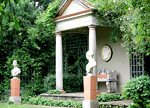Opening The Laskett gardens to the public
Preparations gather pace for opening The Laskett to the public this year as Roy organises flyers and woos the local garden societies


These days, the tree surgeons I use are local. Credit-crunch gardening, which will be the driving force of horticulture for the next decade, I fear-along with ecological issues-makes me look for value for money and ways to cut corners; it affects every garden project. Two beautiful ancient Roman marble pillars came my way in memory of a friend, items I had decided should be placed as focal points of two symmetrical gardens.
But, when I was told the thousands it would cost to bring in a crane to lift them up and over hedges, I opted for siting them virtually where they lay-and that meant moving the four statues I had only repositioned a few weeks before. Mercifully, the gardeners could shift those, and so off they went on their travels again. But I'm pleased with the result, for these splendid columns with their carved capitals act as a magnificent proscenium arch framing the vista.
I've called them the Pillars of Hercules, the boundaries of the antique world and later the emblem of the Emperor Charles V, signalling that his empire had, through the acquisition of the New World, shattered those boundaries.
I have to confess to a genuine adrenaline rush that all this has given me. The flyer advertising the garden openings has arrived, and very pretty it looks, too. I've been told that some 800 societies organise garden visits in the neighbouring counties. Amazing. An excellent firm will despatch the flyer together with a personal letter from me to all of them. And this week, I'm meeting the director of the firm producing the shop merchandise upon which my painter friend Jonathan Myles-Lea has lavished a cornucopia of ideas.
Everything will be of the place, and in that context, I bless the modest commissions I've given to artists through the years and the ongoing relationship with the photographer Clive Bours-nell. So there's no lack of beautiful material on which to draw to imprint onto plates, placemats, mugs, notelets, T-shirts, aprons, tea towels and other ephemera. So Chatsworth watch out! Also, mercifully, the public adores anything with a cat on it, and there's no shortage of moggie material here.
Who would believe that I would spend the years coursing up to 80 in this way? But, in fact, it's given me a project, and I love the idea of sharing what my wife and I created over so many decades with a far larger constituency. After all, when I'm gone, it will be theirs anyway. With all these complex commercial considerations driving me, I'm left wondering where the garden itself has got to. The answer to that lies in my weekly meeting with the gardeners.
The plants we had accumulated in droves and which had been lined up around the small greenhouse have been found homes. The thought that the crumbling lintel of the Temple might crash down on someone prompted its repair. And I keep on looking at the various paths in terms of what I suppose is health and safety, although this is a private garden, which, I am told, is a fact that cannot be repeated often enough in the literature.
Exquisite houses, the beauty of Nature, and how to get the most from your life, straight to your inbox.
Outside, there's precious little stirring. However, I've been entranced by the brilliant scarlet fruits on one of the several versions of Malus Julia that grow here. This new variety was bred by Nick Dunn of F. P. Matthews in memory of my wife, and I was asked to report to him which of them looked the best. This was the one; it's so striking that we're moving it near to the fountain, together with a second tree, as close to it in fruit colour as we can find. That migration enables the two memorial trees to be glimpsed from the breakfast-room windows. With that, I am more than happy.
* For more gardening stories like this every week, subscribe and save
Country Life is unlike any other magazine: the only glossy weekly on the newsstand and the only magazine that has been guest-edited by His Majesty The King not once, but twice. It is a celebration of modern rural life and all its diverse joys and pleasures — that was first published in Queen Victoria's Diamond Jubilee year. Our eclectic mixture of witty and informative content — from the most up-to-date property news and commentary and a coveted glimpse inside some of the UK's best houses and gardens, to gardening, the arts and interior design, written by experts in their field — still cannot be found in print or online, anywhere else.
